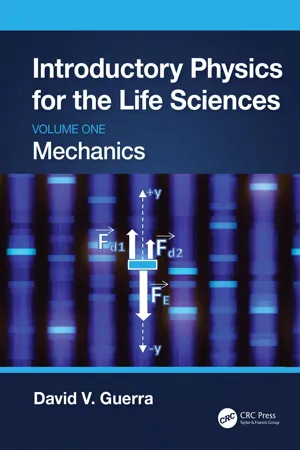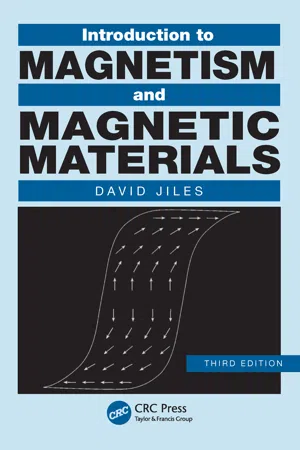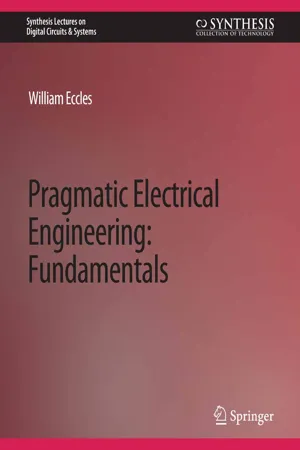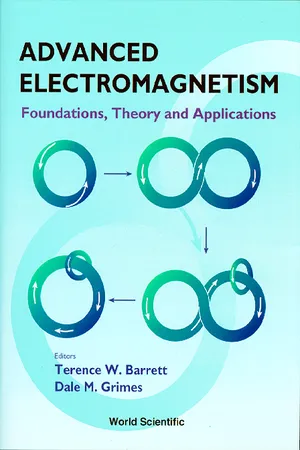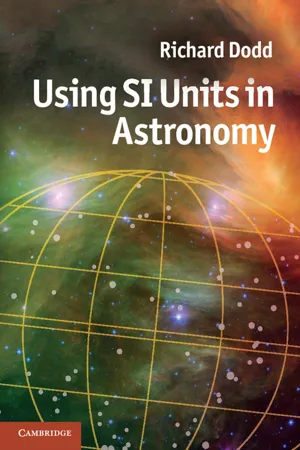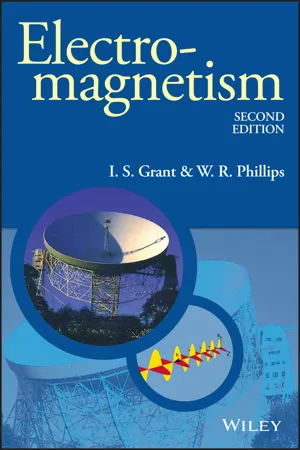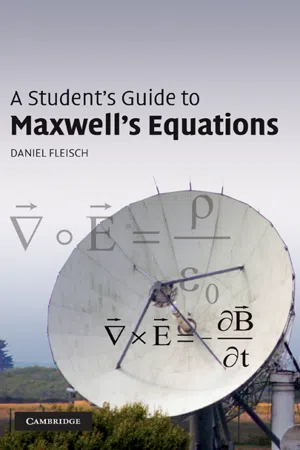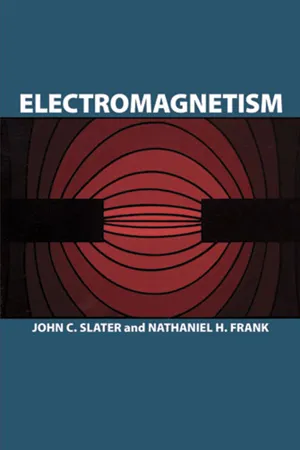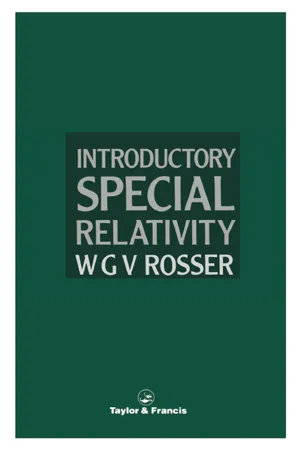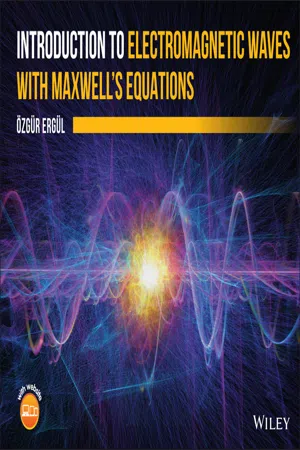Physics
Ampere force
Ampere force refers to the force experienced by two parallel current-carrying conductors due to their magnetic interaction. It is proportional to the product of the currents in the conductors and inversely proportional to the distance between them. This force is a fundamental concept in electromagnetism and is used to explain the behavior of current-carrying wires in magnetic fields.
Written by Perlego with AI-assistance
Related key terms
1 of 5
12 Key excerpts on "Ampere force"
- David V. Guerra(Author)
- 2023(Publication Date)
- CRC Press(Publisher)
r dependence.Ampere also switched one of the currents so the currents were still parallel, but flowing in the opposite direction. In this orientation, the force had the same magnitude, but it was repulsive instead of attractive. Because in practice it is difficult to measure the flow rate of charge through a wire, the Amp is defined as the amount of current in each of the two long straight wires separated by 1 m, which results in a force of 2 × 10−7 N, on each meter of the wires. The force between wires with even a substantial amount of current is very small, thus it is negligible for most situations.The magnetic field is defined by the force on an electric current in a magnet field. As demonstrated in Figure 6.6 , the magnetic field (B →) is defined as flowing from the north (N) to the south (S) pole of the horseshoe magnet and the current flows from left to right across the page.FIGURE 6.6 Magnetic force on a current-carrying wire.The magnitude of the magnetic force (F), which the magnetic field exerts on the segment of the current (I) with a length (L), is perpendicular to the plane defined by the magnetic field and the current is given by equation (6.2) as:where:F = B I L(6.2)|sin|( θ )- F is the force exerted on the wire-segment,
- I is the current in the wire,
- L is the length of that segment of the wire, which is in the magnetic field,
- B is the uniform magnetic field along the entire length of the wire,
- θ is the angle between the magnetic field and the direction of the current.
These relationships can be more easily seen in Figure 6.7 , which includes the forces, currents, and the magnetic field. The dot in the center of the circle is a simple way to represent the force coming out of the page.FIGURE 6.7 The magnetic force on a current-carrying wire.Thus, if the field and the current are in the same direction (θ = 0) the sin(0°) = 0, there is no force. This is consistent with experimental evidence that the force is zero on a current in a magnetic field, which is parallel or antiparallel. The force is maximum when θ = 90° or θ- David Jiles(Author)
- 2015(Publication Date)
- CRC Press(Publisher)
459 Solutions to Exercises CHAPTER 1 E XERCISE 1.1: D EFINITION OF A MPERE The ampere is defined as the current that, when passed along two infinite conduc-tors lying parallel to each other 1 m apart, gives rise to a force per unit length of 2 × 10 − 7 N m − 1 . From Ampère’s circuital law, the magnetic field H at a radial distance a from a long conductor carrying current i is H = i a 2 1 π A m -Therefore, the field at a distance of 1 m from a long linear conductor carrying a current of 1 A is H = -1 2 1 π A m The force per unit length, F / l , on a current-carrying conductor with current i caused by a perpendicular magnetic induction B is F l i = B and in this case F / l = 2 × 10 − 7 N m − 1 , and i = 1 A. Therefore, B = × 2 10 7 -T Now since by definition B = μ 0 H , then the magnetic induction of 2 × 10 − 7 T corre-sponds to a magnetic field in free space of 1/2 π A m − 1 , and so μ π 0 7 1 4 10 = = × B H --H m E XERCISE 1.2: D IFFERENCE BETWEEN H AND B An essay on the difference between B and H should concentrate on the two Maxwell equations, which relate to these quantities: 460 Solutions to Exercises ∇× = + ∂ ∂ ∇× = -∂ ∂ H t t J D E B or equivalently the Ampère circuital law for H , H ⋅ = ∫ dl Ni or its Biot-Savart law form dH i d l r = × 1 4 2 π ˆ r and the Faraday-Lenz law of induction for B , V NA d dt = -B and the Ampère force law (Ampère’s other law) in its various forms F B m B B = × = × = × i dl qv the last of these also being known as the Lorentz force law , although it is essentially just the Ampère force law in a slightly different form. A field strength of 1 A m − 1 is generated at the center of a circular coil of conductor of diameter 1 m when it carries a current of 1 A. A magnetic induction of 1 T generates a force of 1 N m − 1 on a conductor carrying a current of 1 A perpendicular to the direction of the induction. The main difference between these quantities is then clear.- eBook - PDF
Pragmatic Electrical Engineering
Fundamentals
- William Eccles(Author)
- 2022(Publication Date)
- Springer(Publisher)
While this isn’t “general,” most of our magnetic systems involve conductors that are arranged for maximum force. Figure 6.1 shows the basic structure. The conductor on the left is carrying a current, flowing upward, of I 1 amperes. The conductor is infinite in both directions, which is impractical, but as long as the loop is closed “a long way away,” “infinite” is OK. Figure 6.1: Ampere’s Force Law The second conductor in the drawing is carrying a current, flowing downward, of I 2 amperes. We are considering only a part of this conductor, a segment of length . This conductor is a distance r from the first one. Ampère says there’s a force F acting outward between these conductors. The relationship is F I r I = + / 1 2 2 C newtons (N) It’s not surprising that the force depends on the strengths of the two currents. It also should not be surprising that the force diminishes as the distance between the conductors r increases. Also, if we omit the length of the second conductor, the equation becomes the force per unit length, which would be N/m. Most of the formulas we are going to learn about involve a physical constant of some kind, a constant that makes the units work out properly, generally by describing some property of the 6.1. AMPERE’S LAWS 163 material we are working with or in. In this equation, μ is the magic frigger factor that describes the magnetic characteristic of the material.The larger the μ, the more easily is the material magnetizable. 6.1.2 PERMEABILITY μ This μ has a proper name: permeability. If we are working in free space, / 0 7 4 10 = < newtons/ampere (N/A ) 2 2 + In fact, just about everything is “free space” as far as magnetics are concerned. For our purposes, the only materials that have a permeability other than μ are iron and iron-bearing metals plus a few others such as cobalt, nickel, and rare-earth alloys. - Terence William Barrett, Dale M Grimes(Authors)
- 1995(Publication Date)
- World Scientific(Publisher)
As in gravitation, the interaction force decreased with the inverse square of the distance. Soon thereafter Coulomb formulated a similar law for the attraction and repulsion of electric charges. This replaced the mass product of gravitation with the charge product. Ampere [5] continued the Newtonian tradition by deriving a force law for the mechanical interaction of two current elements. This he published in 1822. Unlike masses, magnetic poles, and electric charges, the current elements had a direction in addition to their magnitude and therefore were vector quantities. 638 Ampere's law was again a Newtonian inverse square law, but it involved the angular orientation of the current elements and, therefore, required a more complex formula. The modern definition of the current element, being the product of a charge times its velocity relative to some specified observer, does not apply to Ampere's current element. As Maxwell was later to explain very clearly, Ampere considered his fundamental element to be an infinitely small volume of the metal through which the electric current streamed. The mechanical forces specified by Ampere's law acted on the stationary metal elements. Ampere's formula did not contain a velocity and thereby avoided the problems which Einstein subsequently had to address in the special theory of relativity. Ultimately, it was the definition of the Amperian current element which ensured a Galilean-invariant Newtonian theory which Ampere called electrodynamics. The reason why the Ampere forces could not possibly have acted on the electric fluid was that they would then have interfered with current flow, which they obviously did not. When Lorentz introduced the modern current element, which in most cases was simply the moving conduction electron, he overcame this problem by proposing an electrodynamic force (the Lorentz force) of which the magnetic component was always perpendicular to the current element.- eBook - PDF
- Richard Dodd(Author)
- 2011(Publication Date)
- Cambridge University Press(Publisher)
10 Unit of electric current (ampere) 10.1 SI definition of the ampere The ampere is that constant current which, if maintained in two straight parallel conductors of infinite length, of negligible cross section, and placed 1 metre apart in vacuum, would produce between these conductors a force equal to 2 × 10 −7 newton per metre of length. The dimension of electric current is [I ], its unit is the ampere and its symbol is A. 10.1.1 Possible future definition of the ampere Under discussion at the present time is the redefining of the unit of electric current in the following way: The ampere is a unit of electric current such that the elementary charge is exactly 1.602 176 53 × 10 −19 C, where 1 C (coulomb) = 1A. s (ampere second). 10.1.2 Definition of electricity Funk & Wagnalls New Standard Dictionary of the English Language (1946) gives a general definition of electricity as: Electricity: A material agency which, when in motion, exhibits magnetic, chemical and thermal effects, and which, whether in motion or at rest, is of such a nature that when it is present in two or more localities within certain limits of association, a mutual interaction of force between such localities is observed. And as a physics-related definition of electricity: That branch of science that treats of this agency and the phenomena caused by it. 174 10.2 SI and non-SI electrical and magnetic unit relationships 175 10.1.3 Definition of magnetism Funk et al.(1946) give, as a general definition of magnetism: Magnetism: that quality or agency by virtue of which certain bodies are productive of magnetic force or susceptible to its action. And as a physics-related defintion of magnetism: The science that treats the laws and conditions of magnetic force. - eBook - ePub
- I. S. Grant, W. R. Phillips(Authors)
- 2013(Publication Date)
- Wiley(Publisher)
B (sometimes called the magnetic induction field).The current I 1 in the wire shown on Figure 4.2 gives rise to a field B 1 which describes the forces on the moving charges constituting the current I 2 in the other wire. The current I 2 can be seen from Equation (4.3) to be proportional to the product of the mean speed of the electrons and the electronic charge. Experiments show that the force on the wire carrying the current I 2 is proportional to I 2 , for a fixed current in the first wire. Hence, in a constant magnetic field, the magnitude of the force on a moving charge is proportional to the product of the charge q and the speed υ of the charge.We may do more experiments to determine how the force on a moving charge depends on its velocity and the magnetic field in which it moves. Let us make the reasonable assumption that the field B in the middle of the gap between the parallel pole faces of a large permanent magnet is uniform and in a direction perpendicular to the pole faces, as shown in Figure 4.3 . Experiments with charged particles moving in the gap show that the particles always experience a force F which is perpendicular both to the field direction and to the velocity v of the particles. For example the electron beam of a cathode ray tube placed in the gap is deflected parallel to the pole faces. The magnitude of the force is found to be proportional to the speed of the particle, its charge q, and to the sine of the angle between the vectors v and B. These experiments are illustrated schematically in Figure 4.4 - eBook - ePub
- A.P. French(Author)
- 2017(Publication Date)
- CRC Press(Publisher)
2 . Hence the magnitude of the force on this length of wire is given byF =i.e.,λ 2lv 2()2 kI 1c 2bThis force, as we have seen, is in the plane of the wires. If the currents are in the same direction, the force is attractive. If the currents are oppositely directed, the force is repulsive.F =2 kc 2l =bI 1I 2B 2I 2l( 8-20 )The constant k , remember, is the constant of proportionality in Coulomb’s law. We see now that it appears in the expression for the force between two current-carrying wires and can therefore be used to calculate that force when known currents are flowing. In the MKS system, as we mentioned at the beginning of the chapter, its value is about 9 × 109 newton • m2 /coulomb2 . Using Eq. (8-20) , one can calculate from this that the force per unit length between two parallel wires, 1 cm apart, each carrying a current of 10 amp, is 0.002 newton/m. If there were no positive ions to neutralize the electric field of the electrons, the electric force between the wires would be a factor of c 2 /v 2 greater than this, or about 5 × 1020 newton/m!Units And Systems of Electric and Magnetic Measurement
To wrap up this discussion, as it were, let us return to the quantitative statements of the electric and magnetic force laws with which we began the chapter. The subject of basic units, etc., may often seem rather dull, but the unification of electricity and magnetism through relativity provides a special interest in this case.Equation (8-1) states the basic law of force between electric charges (Coulomb’s law). The last equation [Eq. (8-20) ] states a law of force between parallel currents. The CGS unit of charge was defined by setting the constant k equal to unity in the Coulomb law. But what if we let Eq. (8-20) define our unit of charge? We can do this by asserting that two parallel wires, placed a unit distance apart and each carrying a current of unit strength, repel or attract one another with exactly 2 units of force per unit length. Why 2 units of force and not 1? To correspond with the factor 2 on the right side of Eq. (8-20) . Historically, this was in effect done to define an absolute unit of current, and the units of mechanical measurement were CGS units.1 - eBook - PDF
- Daniel Fleisch(Author)
- 2008(Publication Date)
- Cambridge University Press(Publisher)
To better understand the relationship between magnetic fields and electric currents, Maxwell worked out an elaborate conceptual model in which magnetic fields were represented by mechanical vortices and electric currents by the motion of small particles pushed along by the whirling vortices. When he added elasticity to his model and allowed the magnetic vortices to deform under stress, Maxwell came to understand the need for an additional term in his mechanical version of Ampere’s law. With that understanding, Maxwell was able to discard his mechanical model and rewrite Ampere’s law with an additional source for magnetic fields. That source is the changing electric flux in the Ampere–Maxwell law. Most texts use one of three approaches to demonstrating the need for the changing-flux term in the Ampere–Maxwell law: conservation of charge, special relativity, or an inconsistency in Ampere’s law when applied to a charging capacitor. This last approach is the most common, and is the one explained in this section. Consider the circuit shown in Figure 4.6 . When the switch is closed, a current I flows as the battery charges the capacitor. This current produces The Ampere–Maxwell law 91 a magnetic field around the wires, and the circulation of that field is given by Ampere’s law I C ~ B d ~ l ¼ l 0 I enc ð Þ : A serious problem arises in determining the enclosed current. According to Ampere’s law, the enclosed current includes all currents that penetrate any surface for which path C is a boundary. However, you’ll get very different answers for the enclosed current if you choose a flat membrane as your surface, as shown in Figure 4.7(a) , or a ‘‘stocking cap’’ surface as shown in Figure 4.7(b) . Although current I penetrates the flat membrane as the capacitor charges, no current penetrates the ‘‘stocking cap’’ surface (since the charge accumulates at the capacitor plate). - eBook - PDF
- John D. Cutnell, Kenneth W. Johnson, David Young, Shane Stadler(Authors)
- 2015(Publication Date)
- Wiley(Publisher)
Because a coulomb per second is an ampere (1 C/s 5 1 A, see Section 20.1), the tesla is often written as 1 T 5 1 N/(A ? m). In many situations the magnetic field has a value that is considerably less than one tesla. For example, the strength of the magnetic field near the earth’s surface is approxi- mately 10 24 T. In such circumstances, a magnetic field unit called the gauss (G) is some- times used. Although not an SI unit, the gauss is a convenient size for many applications involving magnetic fields. The relation between the gauss and the tesla is 1 gauss 5 10 24 tesla Example 1 deals with the magnetic force exerted on a moving proton and on a moving electron. B Right hand RHR–1 v F Figure 21.8 Right-Hand Rule No. 1 is illustrated. When the right hand is oriented so the fingers point along the magnetic field B B and the thumb points along the velocity v B of a positively charged particle, the palm faces in the direction of the magnetic force F B applied to the particle. A 584 Chapter 21 | Magnetic Forces and Magnetic Fields EXAMPLE 1 | Magnetic Forces on Charged Particles A proton in a particle accelerator has a speed of 5.0 3 10 6 m/s. The proton encounters a mag- netic field whose magnitude is 0.40 T and whose direction makes an angle of u 5 30.08 with respect to the proton’s velocity (see Figure 21.7c). Find the magnitude and direction of (a) the magnetic force on the proton and (b) the acceleration of the proton. (c) What would be the force and acceleration if the particle were an electron instead of a proton? Reasoning For both the proton and the electron, the magnitude of the magnetic force is given by Equation 21.1. The magnetic forces that act on these particles have opposite directions, however, because the charges have opposite signs. In either case, the acceleration is given by Newton’s second law, which applies to the magnetic force just as it does to any force. - eBook - ePub
- John C. Slater, Nathaniel H. Frank(Authors)
- 2012(Publication Date)
- Dover Publications(Publisher)
Coulomb’s studies were carried on in the latter half of the eighteenth century. Early in the nineteenth came the discovery of the magnetic effects of continuous currents. First was Oersted’s observation that electric current flowing in a loop of wire exerted magnetic forces on permanent magnets, just as if the loop itself were a magnet. Then came Ampere to formulate these observations mathematically, showing that the magnetic force resulting from a circuit can be broken up into contributions from infinitesimal lengths of wire in the circuit, and that each of these forces falls off as the inverse square of the distance, a law often known by the names of Biot and Savart. These laws of action at a distance suggested that electromagnetism would develop along the lines suggested by gravitational theory.Michael Faraday, in the first half of the nineteenth century, was the first who really turned the electromagnetic theory into the lines of field theory. If a piece of insulator, or dielectric, is put between two charged objects, the force between the objects is diminished. Faraday was not content to regard this as merely a shielding effect, or a change in the force constant. He directed attention to the dielectric, and concluded that it became polarized, acquired charges which themselves contributed to the force on other charges. To describe these effects, he introduced the idea of lines of force, lines pointing in the direction of the force that would be exerted on a charge located at an arbitrary point of space. He gave a physical meaning to the number of lines per unit area, setting this quantity proportional to the magnitude of the force. He thought of the lines of force in a very concrete way, as if there were a tension exerted along them, and a pressure at right angles to them, and showed that such a stress system would account for the forces actually exerted on charges. Faraday’s fundamental idea, in other words, was that things of the greatest importance were going on in the apparently empty space between charged bodies, and that electromagnetism could be described by giving the laws of the phenomena in this space, which he called the “field.” His discovery of electromagnetic induction, in which electromotive force is induced in a circuit by the time rate of change of magnetic flux through the circuit, added certainty to his concepts, by pointing out the importance of the magnetic field and its flux. - eBook - ePub
- W G V Rosser(Author)
- 2017(Publication Date)
- CRC Press(Publisher)
The resultant force per unit length on wire 2 is given byf y=f elec+f max=−λ 22 π ∈0r=μ 0λ 2υ 22 πrλ 22 π ∈0r(.1 −)μ 0∈0υ 2(8.4) Numerical substitution of 8.85 × 10−12 F m−1 for ∈0 and 4π × 10−7 H m−1 for μ0 shows that μ0 ∈0 = 1/c2 , where c = 3 × 108 m s−1 is the velocity of light in empty space. Hence the resultant force, electric plus magnetic, on unit length of wire 2 isf y=λ 22 π ∈0r(.1 −)υ 2/c 2(8.5) In this simple case, the ratio of the magnetic force to the electric force is υ2 /c2 , where υ is the velocity of the charges relative to ∑, the inertial reference frame chosen. This illustrates that magnetic forces are of second order in υ/c.Consider a typical case, say a conduction current of 1 A flowing in a copper wire of cross-sectional area, a = 1 mm2 (10−6 m2 ). Let N be the number of charge carriers per unit volume (approximately 8.5 × 1028 m−3 for copper), and let q = −1.6 × 10−19 C be the charge on each electron. The current is given byI = q N a υ ,where υ is the mean drift velocity of the electrons. Substituting, we find υ ≈ 7 × 10−5 m s−1 . If the charges shown in Fig. 8.1 moved with this speed, the ratio of the magnetic to the electric forces given by equation (8.5) would be about 5 × 10−26 . Why then are the magnetic forces between electric circuits so important? In practice, in a copper conductor there is no resultant electric charge inside the conductor, since the charges on the moving electrons are compensated by the positively charged ions, which are virtually at rest in a stationary conductor, as illustrated in Fig. 8.2 . It will be assumed that the total charge per unit length due to the positive ions is λ while that due to the negative electrons is − λ in each conductor measured in the laboratory frame ∑.Fig. 8.2 Forces between two conduction currents I. In the simplified model used the positive ions are at rest and the negative electrons all move with the same uniform velocity υ - Ozgur Ergul(Author)
- 2021(Publication Date)
- Wiley(Publisher)
(2.339) In other words, we are able to use Ampere’s law for the magnetic flux density, while we cannot place the permeability outside the derivative (curl operation). In such a case, the derivative of the permeability (its gradient) may be used to write the complete and correct equation for ¯ ∇ × ¯ B m (¯ r, t ). We may now construct the mathematical basis for the interaction of magnetic fields with magnetic materials, particularly in the context of Ampere’s law. As usual, we list the tools and concepts for this purpose: • Magnetic dipole • Magnetization • Equivalent magnetization currents These are in addition to previous tools: differential length with direction (Section 2.1.1 ), cross product (Section 2.3.2 ), circulation of vector fields (Section 2.1.2 ), electric current den-sity (Section 2.3.1 ), curl of vector fields (Section 2.3.3 ), and Stokes’ theorem (Section 2.3.4 ). Also, we need to know differential surface with direction (Section 1.1.1 ), dot prod-uct (Section 1.1.2 ), and flux of vector fields (Section 1.1.3 ). 2.8.1 Magnetic Dipole As opposed to the existence of electric charges, there is no magnetic charge in nature (Figure 2.80 ). On the other hand, a magnetic dipole, which creates a magnetic field that is similar 82 to the electric field created by an electric dipole, can be defined as a 82 This similarity is particularly for the far zone: i.e. away from the dipole. circular loop carrying a constant electric current (Figure 2.81 ). Consider a steady I 0 flowing Ampere’s law 133 along a loop of radius a located at the origin in a vacuum. The magnetic field intensity at an arbitrary location ¯ r can be found as B -Figure 2.82 Magnetic field lines for a magnetic dipole. Magnetic dipoles are very useful to describe various phenomena, such as magnetization.
Index pages curate the most relevant extracts from our library of academic textbooks. They’ve been created using an in-house natural language model (NLM), each adding context and meaning to key research topics.
